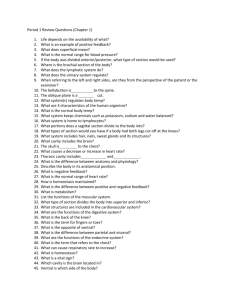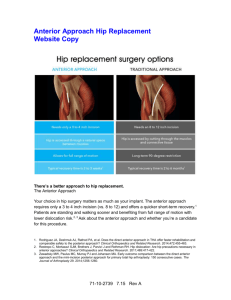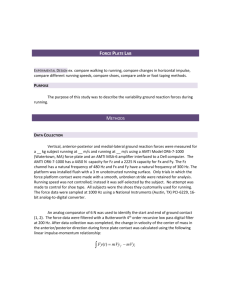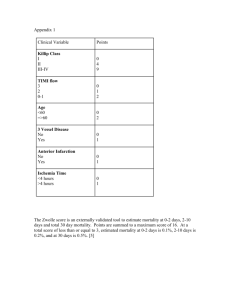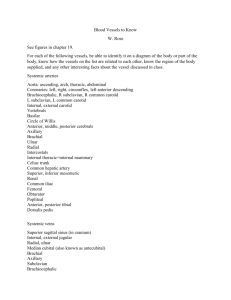A GENUS LEVEL PHYLOGENETIC ANALYSIS OF THE
advertisement
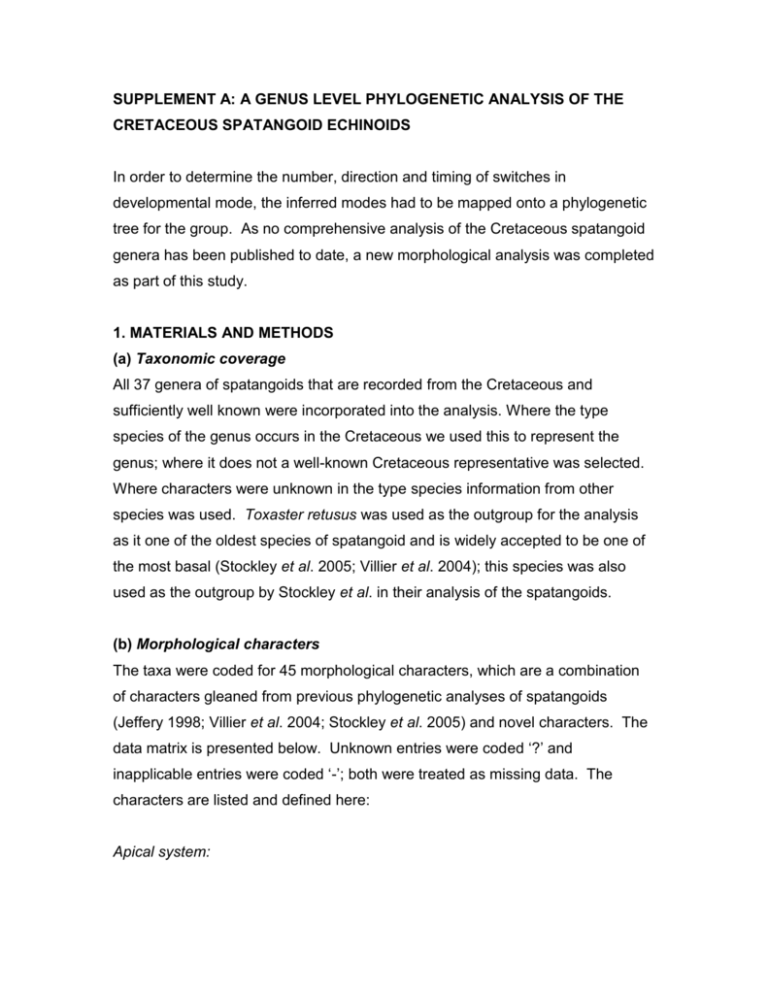
SUPPLEMENT A: A GENUS LEVEL PHYLOGENETIC ANALYSIS OF THE CRETACEOUS SPATANGOID ECHINOIDS In order to determine the number, direction and timing of switches in developmental mode, the inferred modes had to be mapped onto a phylogenetic tree for the group. As no comprehensive analysis of the Cretaceous spatangoid genera has been published to date, a new morphological analysis was completed as part of this study. 1. MATERIALS AND METHODS (a) Taxonomic coverage All 37 genera of spatangoids that are recorded from the Cretaceous and sufficiently well known were incorporated into the analysis. Where the type species of the genus occurs in the Cretaceous we used this to represent the genus; where it does not a well-known Cretaceous representative was selected. Where characters were unknown in the type species information from other species was used. Toxaster retusus was used as the outgroup for the analysis as it one of the oldest species of spatangoid and is widely accepted to be one of the most basal (Stockley et al. 2005; Villier et al. 2004); this species was also used as the outgroup by Stockley et al. in their analysis of the spatangoids. (b) Morphological characters The taxa were coded for 45 morphological characters, which are a combination of characters gleaned from previous phylogenetic analyses of spatangoids (Jeffery 1998; Villier et al. 2004; Stockley et al. 2005) and novel characters. The data matrix is presented below. Unknown entries were coded ‘?’ and inapplicable entries were coded ‘-’; both were treated as missing data. The characters are listed and defined here: Apical system: 1. Position of apical disc. Central (35-55% of test length from the anterior margin) (0); anterior (<35%) (1); posterior (>55%) (2). 2. Number of genital pores: four (0); three, genital plate 2 without opening (1); three, genital plate 4 without opening (2); two, genital plates 2 and 3 without openings (3). 3. Apical disc plating: ethmophract with ocular IV insert (0); ethmophract (1); semi-ethmolytic (2); ethmolytic (3). Anterior ambulacrum: 4. Depth of anterior ambulacrum midway between apex and ambitus. Flush (0); shallowly concave (1); at least as deep as wide (2). 5. Depth of anterior ambulacrum at ambitus. Flat or convex in plan view (0); shallowly concave in plan view (1); at least as deep as wide forming prominent notch in plan view (2). 6. Depth of anterior ambulacrum on oral surface. Flush (0); shallowly concave without distinct edges (1); forming a distinct channel with sharply defined edges (2). 7. Length of petaloid part of anterior ambulacrum. Extending 60-90% of the distance from the apical system to the ambitus (1); short, extending approximately 50% of the distance from the apical system to the ambitus (0). 8. Pores in anterior ambulacrum: uniform (0); heterogenous (1). 9. Type of pore pairs in anterior ambulacrum. Oval pore-pairs (0); asymmetrical, elongate pore-pairs (1). 10. Width to length ratio of plates in anterior ambulacrum (measured midway between the apical system and ambitus). <1.5 (0); 1.5-5.0 (1); >5.0 (2). Paired ambulacra 11. Relative lengths of anterior and posterior petals (equipetality). 1.0-1.5 (0); >1.5 (1); <1.0 (2). Apetaloid taxa are scored ‘?’. 12. Paired petals: flush (0); sunken (1). 13. Divergence of paired petals at longest straight part. 90-130º (0); >130º (1); <90º (2). 14. Axis of paired petals. Straight (0); anterior and/or posterior paired petals sinuous (1); weakly curved near apex (2). 15. Type of pore-pairs in paired ambulacra: oval pore-pairs (0); asymmetrical elongate pore-pairs (1); slit-like, symmetrical elongate pore-pairs (2). 16. Pore-pairs strongly reduced in anterior branch of anterior ambulacrum. No (0); yes (1). 17. Distal termination of petal. Petal pore-pairs decrease in size gradually and there is no abrupt end to the petals (0); Petal pore-pairs end abruptly (1). 18. Termination of paired posterior petals. Sub-petaloid (0); divergent (1); closed (2). 19. Ambulacra pinched at ends of petals. No (0); yes (1). 20. Petal shape. The two columns parallel along their length (0); petals lanceolate: widened in the middle and converging distally (1); petals gradually widening distally (2). 21. Anterior paired petal length. Short, extending only about half the distance to the ambitus (0); extending between 0.6 and 0.9 of the radial length (1); reaching the ambitus in plan view (2). Apetaloid taxa are coded ‘?’. 22. Pore-pairs in petals. The two columns closely spaced leaving almost no perradial zone (0); separated by more than 1.5 times the pore-pair width (1). 23. Very broad and strongly bowed petals. No (0); yes (1). Interambulacra and plastron 24. The number of the ambulacral plate abutting the rear suture of the labral plate in interambulacrum I. One (0); two (1); three (2); four or more (3). 25. The number of the ambulacral plate abutting the rear suture of the sternal plate in interambulacrum I. Five (0); six (1); seven or eight (2); nine or more (3); three or four (4). 26. Suture between labral and sternal plates. Straight (0); strongly curved (1). 27. Suture between sternal plates. Oblique with plate 2a extending considerably further towards ambitus than 2b (0); oblique with suture between 2a and 3a approximately level with that between 2b and 3b ; vertical – sternal plates symmetrical (2). 28. Labral plate. In contact with both sternal plates (0); in contact with only sternal plate 2b (1). 29. Interambulacra 1 and 5. Both amphiplacous (0); one meridoplacous, one amphiplacous (1); both meridoplacous (2). 30. Plastron: widening to the rear (0). More or less parallel sided (1). 31. Length of labral plate relative to that of sternal plates. <20% (0); 20-50% (1); >50% (2). Peristome 32. Position of peristome. >15% of test length from the anterior margin (0); <15% of test length from the anterior margin (1). 33. Peristome shape. Circular to ovate (0); distinctly pentagonal (1). 34. Peristome orientation. Downward-facing (appears ovate or pentagonal when viewed from below, labrum not projecting below plane of opening) (0); obliquely facing forwards (labral plate strongly projecting so peristome appears C-shaped) (1); vertical (peristome almost entirely hidden by labral plate in plan view) (2). 35. Peristome surrounded by a distinct rim. No (0); yes (1). Periproct 36. Shape of periproct. Round or wider than high (0); high with pointed tips (1). Fascioles 37. Peripetalous fasciole. Absent (0); present (1). 38. Peripetalous/semipetalous fasciole. Independent of other fascioles (0); unites with marginal fasciole around anterior (1). 39. Peripetalous band in lateral interambulacra. Not indented (0); indented behind anterior paired petals (1). 40. Fasciole bounds the ends of the anterior paired petals. Yes (0); no (1). 41. Subanal fasciole ring. Absent (0); present (1). 42. Fasciole crossing posterior interambulacrum below anus and continuing as a marginal/lateroanal band. Absent (0); present (1). 43. Aboral tuberculation with small primary tubercles set in a groundmass of fine dense uniform granules: no (0); yes (1). Test shape 44. Posterior end of the test. Rounded (0); truncated (1); prominent rostrum (2). 45. Test with prominent nodules on the lower surface. No (0); yes (1). (c) Analytical methods The dataset was analysed here using parsimony within the computer programme PAUP* (Swofford 2002). All characters were assigned equal weight and were treated as unordered. To construct the trees an initial heuristic search (1000 replicates; TBR; ACCTRAN) was carried out. Characters were then re-weighted according to their Rescaled Consistency Index (RCI) in the initial analysis. A second heuristic search (1000 replicates; TBR; ACCTRAN) was then carried out. A strict consensus tree was then used to summarise the information given in the Most Parsimonious Trees (MPTs). The consistency index (CI) and retention index (RI) were both noted as measures of robustness. To produce an index of support, the bootstrap technique (Felsenstein 1985) was used (fast stepwise-addition, 1000 replicates). The results were presented on the strict consensus tree. 2. RESULTS AND DISCUSSION The initial heuristic search produced 683 MPTs of 223 steps with CI 0.314 (0.305 with uninformative characters excluded) and RI 0.557. When the analysis was repeated after a posteriori character re-weighting according to RCI three MPTs were recovered with CI 0.426 (0.392 with uninformative characters excluded) and RI 0.652. The three MPTs differed only in the postion of Epiaster. A strict consensus tree was used to summarise the relationships common to all three MPTs; this is presented in Supplementary Figure 1 with bootstrap values (above 50%) displayed above each branch. While statistical support for many of the clades recovered is low, the support values are comparable to those found in other genus level analyses of fossil irregular echinoids (e.g. Smith 2004; Barras 2006, 2007). Supplementary Figure 1. Strict consensus tree of Cretaceous spatangoid genera. See text for details of phylogenetic analysis. Bootstrap values, where above 50%, are displayed above branches. REFERENCES Barras, C. G. 2006 British Jurassic irregular echinoids. Monograph of the Palaeontographical Society, London. 168 pp., 14 pls. Barras, C. G. 2007 Phylogeny of the Jurassic to Early Cretaceous 'disasteroid' echinoids (Echinoidea; Echinodermata) and the origins of spatangoids and holasteroids. Journal of Systematic Palaeontology 5, 133-161. Felsenstein, J. 1985 Confidence-limits on phylogenies - an approach using the bootstrap. Evolution 39, 783-791. Jeffery, C. H. 1998 Carrying on regardless: the echinoid genus Cyclaster at the Cretaceous-Tertiary boundary. Lethaia 31, 149-157. Smith, A. B. 2004 Phylogeny and systematics of holasteroid echinoids and their migration into the deep-sea. Palaeontology 47, 123-150. Stockley, B., Smith, A. B., Littlewood, T., Lessios, H. A. & Mackenzie-Dodds, J. A. 2005 Phylogenetic relationships of spatangoid sea urchins (Echinoidea): taxon sampling density and congruence between morphological and molecular estimates. Zoologica Scripta 34, 447-468. Swofford, D. L. 2002. PAUP* Phylogenetic analysis using parsimony (*and other methods). Version 4. Sunderland, MA: Sinauer Associates. Villier, L., Neraudeau, D., Clavel, B., Neumann, C. & David, B. 2004 Phylogeny of Early Cretaceous spatangoids (Echinodermata : Echinoidea) and taxonomic implications. Palaeontology 47, 265-292. Data matrix Toxaster Heteraster Mokotibaster Macraster Epiaster Pliotoxaster Iraniaster Palhemiaster Mecaster Lambertiaster Holcopneustes Polydesmaster Periaster Abatus Linthia Schizaster Tessieria Holanthus Leiostomaster Bolbaster Hemiaster Leymeriaster Proraster Mauritanaster Heterolampas Plesiaster Diplodetus Gibbaster Isaster Cyclaster Micraster Turanglaster Ovulaster Homoeaster Orthaster Coraster Cottreaucorys 1 11 21 31 0001110011 ?121100102 1103110000 2000000000 0001110112 0021110102 1?03200000 2000000000 0020010?12 0000?00100 20032020?1 2000000- - 0 0011110011 0102100100 2003210000 1011001000 0021110011 0000200101 11021100?0 ?000110- - 0 0021110012 0102200101 100??100?0 ?000000000 0021110001 0102201100 10021- 0110 1100001000 0021110000 0102101201 1002?100?0 1010011010 00(23)1110002 0102201201 10022020?0 1011011010 0031110000 0100201200 1003102000 2010?01011 1031110002 0100201200 100??020?0 ?0?1??1001 0022211002 0100(12)01200 1101200000 00010010?0 00(12)1110001 0102101201 1001102001 0001011110 2331100001 0122101201 1100102000 0001011110 0031110001 0102101201 1001002001 0011011110 003111?001 1102101201 1001002000 0001011110 0031110001 1102101201 100??020?0 0001011110 0011000001 0100101211 1011(01)02000 1000001010 0021001000 0102?01201 101??120?0 ?0101010?0 0011000001 1100001201 10010020?0 1001001000 0011110001 1100001201 1002110000 1001101000 0021001002 1100101201 100??110?0 ?001111010 2022211001 1121111211 1001002000 1001011000 103111?000 2110101201 200??020?1 ?0010?10?0 0021010011 2110101201 2003302000 1000011000 00111?0001 0102101101 1101010000 1011000- - 0011110002 0100?01100 0?01002000 1002100- - 0011211012 0102?00100 1001102011 11?2000- - 011000100? 0100?00100 0001(01)02000 2000100- - 0111111001 0100(12)01100 0001102001 1102001010 00(12)1110001 0102100000 1001002001 1102000- - 0010?1?00? ?00?000002 ??03001000 2111000- - 101111?00? ?110(03)00002 ?102002001 20?1000- - 1011110001 0112100002 2001002000 2011001001 121011?002 ?010000002 ?101?020?1 2101001010 102001?001 ?010(03)00002 ?101402021 200200101101001?001 ?010000002 ??01402001 200100101- 41 00010 00010 00000 00010 00100 000?0 00010 00010 00010 00010 00010 01010 01010 01010 01010 01010 01011 00010 00010 00000 00010 00010 00010 ??010 00010 10110 10110 10110 10100 10110 10110 10110 10110 00010 00010 00010 00020


